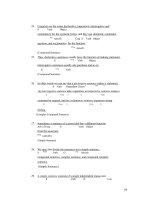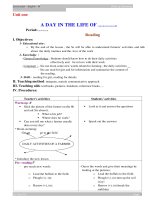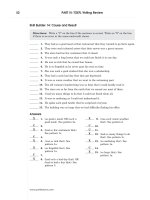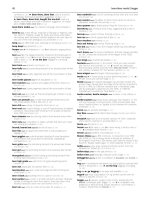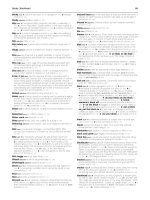English comprehesion 10 pps
Bạn đang xem bản rút gọn của tài liệu. Xem và tải ngay bản đầy đủ của tài liệu tại đây (91.35 KB, 6 trang )
28. It can be inferred from the passage that the Sami
were known as “peaceful retreaters” because they
a. were afraid of foreign invaders.
b. were not citizens of any country and therefore
could not be drafted.
c. refused to learn to use modern weapons and
so were easily defeated.
d. would simply disappear in wartime.
29. Which of the following is NOT a category of the
Sami people?
a. the Forest Sami
b. the Sea Sami
c. the Mountain Sami
d. the Reindeer Sami
Questions 30–35 are based on the following passage.
(1) Milton Hershey was born near the small village
of Derry Church, Pennsylvania, in 1857. It was a
________ beginning that did not foretell his later
popularity. Milton only attended school through
the fourth grade; at that point, he was apprenticed
to a printer in a nearby town. Fortunately for all
chocolate lovers, Milton did not excel as a printer.
After a while, he left the printing business and was
apprenticed to a candy maker in Lancaster, Penn-
sylvania. It was apparent he had found his calling in
life and, at the age of eighteen, he opened his own
candy store in Philadelphia. In spite of his talents as
a candy maker, the shop failed after six years.
(2) It may come as a surprise to Milton Her-
shey’s fans today that his first candy success came
with the manufacture of caramel. After the failure of
his Philadelphia store, Milton headed for Denver,
where he learned the art of making caramels. There
he took a job with a local manufacturer who insisted
on using fresh milk in making his caramels; Milton
saw that this made the caramels especially tasty.
After a time in Denver, Milton once again attempted
to open his own candy-making businesses, in
Chicago, New Orleans, and New York City. Finally,
in 1886, he went to Lancaster, Pennsylvania, where
he raised the money necessary to try again. This
company—the Lancaster Caramel Company—
made Milton’s reputation as a master candy maker.
(3) In 1893, Milton attended the Chicago
International Exposition, where he saw a display of
German chocolate-making implements. Captivated
by the equipment, he purchased it for his Lancaster
candy factory and began producing chocolate, which
he used for coating his caramels. By the next year,
production had grown to include cocoa, sweet
chocolate, and baking chocolate. The Hershey
Chocolate company was born in 1894 as a subsidiary
of the Lancaster Caramel Company. Six years later,
Milton sold the caramel company, but retained the
rights, and the equipment, to make chocolate. He
believed that a large market of chocolate consumers
was waiting for someone to produce reasonably
priced candy. He was right.
(4) Milton Hershey returned to the village
where he had been born, in the heart of dairy coun-
try, and opened his chocolate manufacturing plant.
With access to all the fresh milk he needed, he began
producing the finest milk chocolate. The plant that
opened in a small Pennsylvania village in 1905 is
today the largest chocolate factory in the world. The
confections created at this facility are favorites in the
United States and internationally.
(5) The area where the factory is located is
now known as Hershey, Pennsylvania. Within the
first decades of its existence, the town of Hershey
thrived, as did the chocolate business. A bank, a
school, churches, a department store, even a park
and a trolley system all appeared in short order; the
town soon even had a zoo. Today, a visit to the area
reveals the Hershey Medical Center, Milton Her-
shey School, and Hershey’s Chocolate World, a
theme park where visitors are greeted by a giant
Reese’s Peanut Butter Cup. All of these things—and
a huge number of happy chocolate lovers—were
made possible because a caramel maker visited the
Chicago Exposition of 1893!
– THEA PRACTICE EXAM 1–
35
30. According to information contained in the pas-
sage, the reader can infer which of the following?
a. Chocolate is popular in every country in the
world.
b. Reese’s Peanut Butter Cups are manufactured
by the Hershey Chocolate Company.
c. Chocolate had never been manufactured in
the U.S. before Milton Hershey did it.
d. The Hershey Chocolate Company now makes
more money from Hershey’s Chocolate World
than from the manufacture and sale of
chocolate.
31. Which of the following best defines the word
subsidiary as used in paragraph 3?
a. a company owned entirely by one person
b. a company founded to support another
company
c. a company that is not incorporated
d. a company controlled by another company
32. The writer’s main purpose in this passage is to
a. recount the founding of the Hershey Choco-
late Company.
b. describe the process of manufacturing
chocolate.
c. compare the popularity of chocolate to other
candies.
d. explain how apprenticeships work.
33. According to the passage, Milton Hershey sold
his caramel company in
a. 1894.
b. 1900.
c. 1904.
d. 1905.
34. The mention of the Chicago International Expo-
sition of 1893 in the passage indicates that
a. the exposition in Chicago is held once every
three years.
b. the theme of the exposition of 1893 was “Food
from Around the World.”
c. the exposition contained displays from a vari-
ety of countries.
d. the site of the exposition is now a branch of
the Hershey Chocolate Company.
35. Which of the following words best fits in the
blank in paragraph 1 of the passage?
a. dramatic
b. modest
c. undignified
d. rewarding
Questions 36–42 are based on the following passage.
(1) Scientists have developed (a/an) ________ pro-
cedure that reveals details of tissues and organs that
are difficult to see by conventional magnetic reso-
nance imaging (MRI). By using “hyperpolarized”
gases, scientists have taken the first clear MRI pic-
tures of human lungs and airways. Researchers hope
the new technique will aid the diagnosis and treat-
ment of lung disorders, and perhaps lead to
improved visualization of blood flow.
(2) The air spaces of the lungs have been noto-
riously difficult for clinicians to visualize. Chest X
rays can detect tumors or inflamed regions in the
lungs but provide poor soft-tissue contrast and no
clear view of air passages. Computed-tomography,
a cross-sectional X ray scan, can provide high reso-
lution images of the walls of the lungs and its airways
but gives no measure of function. Conventional
MRI, because it images water protons, provides poor
images of the lungs, which are filled with air, not
water.
– THEA PRACTICE EXAM 1–
36
(3) The new MRI technique detects not water,
but inert gases whose nuclei have been strongly
aligned, or hyperpolarized, by laser light. Initially
this technique seemed to have no practical applica-
tion, but exhaustive research has proven its poten-
tial. Scientists plan to further refine this technology
with animal and human studies, in part because
they have yet to produce a viable three-dimensional
image of human lungs.
(4) By 1995 researchers had produced the first
three-dimensional MRI pictures of a living animal’s
lungs. In the first human test, a member of the
research team inhaled hyperpolarized helium-3. His
lungs were then imaged using a standard MRI scan-
ner that had been adjusted to detect helium. The
results were impressive, considering that the system
had yet to be optimized and there was only a rela-
tively small volume of gas with which to work.
(5) When a standard MRI is taken, the patient
enters a large magnet. Many of the body’s hydrogen
atoms (primarily the hydrogen atoms in water) align
with the magnetic field like tiny bar magnets, and the
nucleus at the center of each atom spins constantly
about its north-south axis. Inside the MRI scanner,
a radio pulse temporarily knocks the spinning nuclei
out of position, and as their axes gradually realign
within the magnetic field, they emit faint radio sig-
nals. Computers convert these faint signals into an
image.
(6) The new gas-based MRI is built around
similar principles. But circularly polarized light,
rather than a magnet, is used to align spinning
nuclei, and the inert gases helium-3 or xenon-129
(rather than hydrogen) provide the nuclei that emit
the image-producing signals. The laser light polar-
izes the gases through a technique known as spin
exchange. Helium-3 and xenon-129 are ideal for
gas-based MRI because they take hours to lose
their polarization. Most other gases readily lose their
alignment. The clarity of an MRI picture depends in
part on the volume of aligned nuclei.
36. The MRI innovation is different from the stan-
dard MRI in that it
a. distinguishes gases rather than water.
b. uses magnets rather than light.
c. has a range of useful applications.
d. provides better images of blood circulation.
37. The inability to generate satisfactory images of
air routes is a deficiency of
a. computed tomography.
b. the spin exchange process.
c. three-dimensional pictures.
d. X rays.
38. MRIs transmit radio signals
a. before nuclei rotate on an axis.
b. before atoms align with magnets.
c. after nuclei are aligned by magnetism.
d. after signals are transformed into pictures.
39. The word that can best be interchanged with
hyperpolarization in the passage is
a. visualization.
b. alignment.
c. emission.
d. tomography.
40. The use of which of the following is substituted
for the use of a magnet in one of the MRI tech-
niques?
a. light
b. hydrogen
c. helium-3
d. X rays
41. An image lacking in clarity is likely to be the
result of
a. a high number of aligned nuclei.
b. hydrogen being replaced with xenon.
c. an abbreviated period of alignment.
d. nuclei regaining their aligned position.
– THEA PRACTICE EXAM 1–
37
42. Which of the following words would fit best in
the blank in the first paragraph of the passage?
a. explicit
b. costly
c. innovative
d. clever
Section 2: Mathematics
1. A company makes several items, including filing
cabinets. One-third of their business consists of
filing cabinets, and 60% of their filing cabinets
are sold to businesses. What percent of their total
business consists of filing cabinets sold to busi-
nesses?
a. 20%
b. 33%
c. 40%
d. 60%
2. If the speed of light in air is 3.00 ϫ 10
8
meters
per second, how far would a beam of light travel
in 2,000 seconds?
a. 1.50 ϫ 10
5
meters
b. 6.00 ϫ 10
5
meters
c. 1.50 ϫ 10
11
meters
d. 6.00 ϫ 10
11
meters
3. Lefty keeps track of each length of the fish that he
catches. Below are the lengths in inches of the
fish that he caught one day:
12, 13, 8, 10, 8, 9, 17
What is the median fish length that Lefty caught
that day?
a. 8 inches
b. 10 inches
c. 11 inches
d. 12 inches
Questions 4 and 5 are based on the following graph.
4. According to the graph, what month in 2003 had
the most rainfall?
a. January
b. February
c. November
d. December
5. What was the average (mean) rainfall in Febru-
ary for the three years?
a. 4 inches
b. 5 inches
c. 6 inches
d. 7 inches
6. The Chen family traveled 75 miles to visit rela-
tives. If they traveled 43
ᎏ
1
3
ᎏ
miles before they
stopped at a gas station, how far was the gas sta-
tion from their relatives’ house?
a. 31
ᎏ
2
3
ᎏ
miles
b. 32
ᎏ
2
3
ᎏ
miles
c. 35 miles
d. 38
ᎏ
1
3
ᎏ
miles
Rainfall 2002–2004
Rainfall, Inches
12
10
8
6
4
2
0
Jan
M
ay
Apr
M
ar
Feb
Nov
Oct
Sep
Aug
Jul
Jun
Dec
Month
2002
2003
2004
– THEA PRACTICE EXAM 1–
38
7. Julie counts the cars passing her house, and finds
that 2 of every 5 cars are foreign. If she counts for
an hour, and 60 cars pass, how many of them are
likely to be domestic?
a. 12
b. 24
c. 30
d. 36
8. A steel beam 15 feet long is cut into 4 pieces. The
first piece consists of
ᎏ
1
3
ᎏ
of the beam, the second is
ᎏ
1
6
ᎏ
of the beam, and the third piece is
ᎏ
1
1
0
ᎏ
of the
beam. How long is the remaining piece of the
beam?
a. 1
ᎏ
1
2
ᎏ
feet
b. 2
ᎏ
1
2
ᎏ
feet
c. 6 feet
d. 9 feet
9. A bag of jellybeans contains 8 black beans, 10
green beans, 3 yellow beans, and 9 orange beans.
What is the probability of selecting either a
yellow or an orange bean?
a.
ᎏ
1
1
0
ᎏ
b.
ᎏ
2
5
ᎏ
c.
ᎏ
1
4
5
ᎏ
d.
ᎏ
1
3
0
ᎏ
10. Dimitri has 40 math problems to do for home-
work. If he does 40% of the assignment in one
hour, how long will it take for Dimitri to com-
plete the whole assignment?
a. 1.5 hours
b. 2.0 hours
c. 2.5 hours
d. 4.0 hours
Question 11 is based on the following table.
STEVE’S BIRDWATCHING PROJECT
NUMBER OF
DAY RAPTORS SEEN
Monday
Tuesday 7
Wednesday 12
Thursday 11
Friday 4
Mean 8
11. The table above shows the data Steve collected
while watching birds for one week. How many
raptors did Steve see on Monday?
a. 6
b. 8
c. 10
d. 12
12. Which of the following numbers is NOT between
–0.02 and 1.02?
a. –0.15
b. –0.015
c. 0
d. 0.02
– THEA PRACTICE EXAM 1–
39
Question 13 is based on the following table.
13. What were the total taxes collected for January,
February, and April?
a. $78,000
b. $98,000
c. $105,000
d. $115,000
Question 14 is based on the following table.
BLUE ROUTE BUS SCHEDULE
DEPOT WASHINGTON ST.
Bus 1 6:00 6:53
Bus 2 6:30 7:23
Bus 3 7:00 7:53
Bus 4 7:20
Bus 5 7:40 8:33
14. According to the table, what time is Bus 4 sched-
uled to arrive at Washington Street?
a. 8:03
b. 8:10
c. 8:13
d. 8:18
15. Membership dues at Arnold’s Gym are $53 per
month this year, but were $50 per month last
year. What was the percent increase in the gym’s
prices?
a. 5.5%
b. 6.0%
c. 6.5%
d. 7.0%
Question 16 is based on the following diagram.
16. In the figure, angle POS measures 90 degrees.
What is the measure of angle ROQ?
a. 30 degrees
b. 45 degrees
c. 90 degrees
d. 180 degrees
P R
O
S Q
Month
Monthly Taxes
Taxes, Dollars
50,000
40,000
30,000
20,000
10,000
0
Jan
Feb
Mar
Apr
May
– THEA PRACTICE EXAM 1–
40
